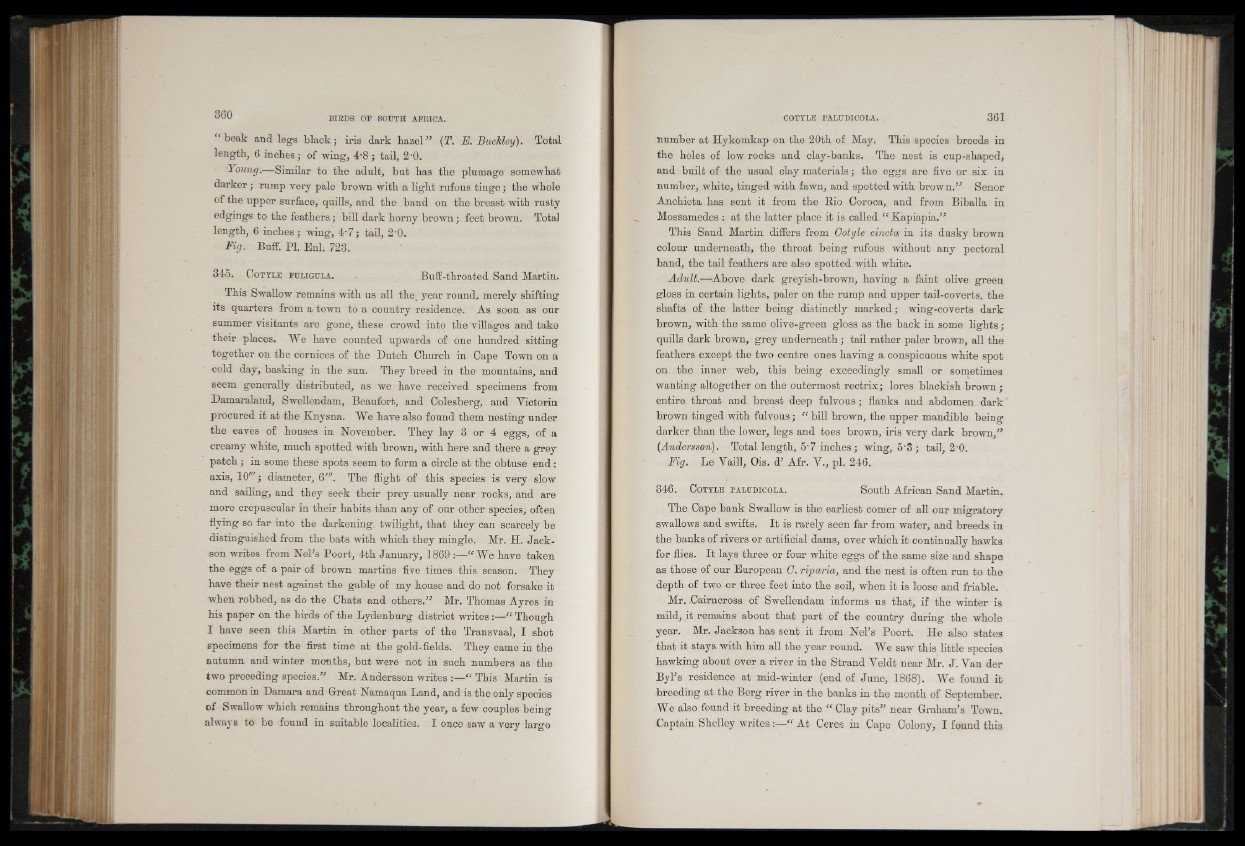
“ beak and legs black; iris dark hazel” (T. E. Buckley). Total
length, 6 inches; of wing, 4*8; tail, 2'0.
'Young.—Similar to the adult, but has the plumage somewhat
darker; rump very pale brown with a light rufous tinge; the whole
of the upper surface, quills, and the band on the breast with rusty
edgings to the feathers; bill dark horny brown; feet brown. Total
length, 6 inches; wing, 4-7; tail, 2'0.
Mg. Buff. PI. Enl. 728.
345. C otyle fuligula. Buff-throated Sand Martin.
This Swallow remains with us all the year round, merely shifting
its quarters from a town to a country residence. As soon as our
summer visitants are gone, these crowd into the villages and take
their places. We have counted upwards of one hundred sitting
together on the cornices of the Dutch Church in Cape Town on a
cold day, basking in the sun. They breed in the mountains, and
seem generally distributed, as we have received specimens from
Damaraland, Swellendam, Beaufort, and Colesberg, and Vietorin
procured it at the Knysna. We have also found them nesting under
the eaves of houses in November. They lay 3 or 4 eggs, of a
creamy white, much spotted with brown, with here and there a grey
patch; in some these spots seem to form a circle at the obtuse end:
axis, 1 O'"; diameter, 6'". The flight of this species is very slow
and sailing, and they seek their prey usually near rocks, and are
more crepuscular in their habits than any of our other species, often
flying so far into the darkening, twilight, that they can scarcely be
distinguished from the bats with which they mingle. Mr. H. Jackson
writes from Nel’s Poort, 4th January, 1869 “ We have taken
the eggs of a pair of brown martins five times this season. They
have their nest against the gable of my house and do not forsake it
when robbed, as do the Chats and others.” Mr. Thomas Ayres in
his paper on the birds of the Lydenburg district writes :—“ Though
I have seen this Martin in other parts of the Transvaal, I shot
specimens for the first time at the gold-fields. They came in the
autumn and winter months, but were not in such numbers as the
two preceding species.” Mr. Andersson writes :—“ This Martin is
common in Damara and Great Namaqua Land, and is the only species
of Swallow which remains throughout the year, a few couples being
always to be found in suitable localities. I once saw a very largo
number at Hykomkap on the 20th of May. This species breeds in
the holes of low rocks and clay-banks. The nest is cup-shaped,
and built of the usual clay materials; the eggs are five or six in
number, white, tinged with fawn, and spotted with brown.” Senor
Anchieta has sent it from the Rio Coroca, and from Biballa in
Mossamedes : at the latter place it is called “ Kapiapia.”
This Sand Martin differs from Gotyle cincta in its dusky brown
colour underneath, the throat being rufous without any pectoral
band, the tail feathers are also spotted with white.
Adult.—Above dark greyish-brown, having a faint olive green
gloss in certain lights, paler on the rump and upper tail-coverts, the
shafts of the latter being distinctly marked; wing-coverts dark
brown, with the same olive-green gloss as the back in some lights;
quills dark brown, grey underneath ; tail rather paler brown, all the
feathers except the two centre ones having a conspicuous white spot
on the inner web, this being exceedingly small or sometimes
wanting altogether on the outermost rectrix; lores blackish brown ;
entire throat and breast deep fulvous; flanks and abdomen dark
brown tinged with fulvous; “ bill brown, the upper mandible being
darker than the lower, legs and toes brown, iris very dark brown,”
(Andersson). Total length, 5‘7 inches; wing, 5-3 ; tail, 2’0.
Fig. Le Vaill, Ois. d’ Afr. Y., pi. 246.
346. C otyle paludicola. South A f r ic a n Sand Martin.
The Cape bank Swallow is the earliest comer of all our migratory
swallows and swifts. It is rarely seen far from water, and breeds in
the banks of rivers or artificial dams, over which it continually hawks
for flies. It lays three or four white eggs of the same size and shape
as those of our European G.riparia, and the nest is often run to the
depth of two or three feet into the soil, when it is loose and friable.
Mr, Cairn cross of Swellendam informs us that, if the winter is
mild, it remains about that part of the country during the whole
year. Mr. Jackson has sent it from Nel’s Poort. He also states
that it stays with him all the year round. We saw this little species
hawking about over a river in the Strand Yeldt near Mr. J. Van der
Byl’s residence at mid-winter (end of June, 1868). We found it
breeding at the Berg river in the banks in the month of September.
We also found it breeding at the “ Clay pits” near Graham’s Town.
Captain Shelley writes:—“ At Ceres in Cape Colony, I found this